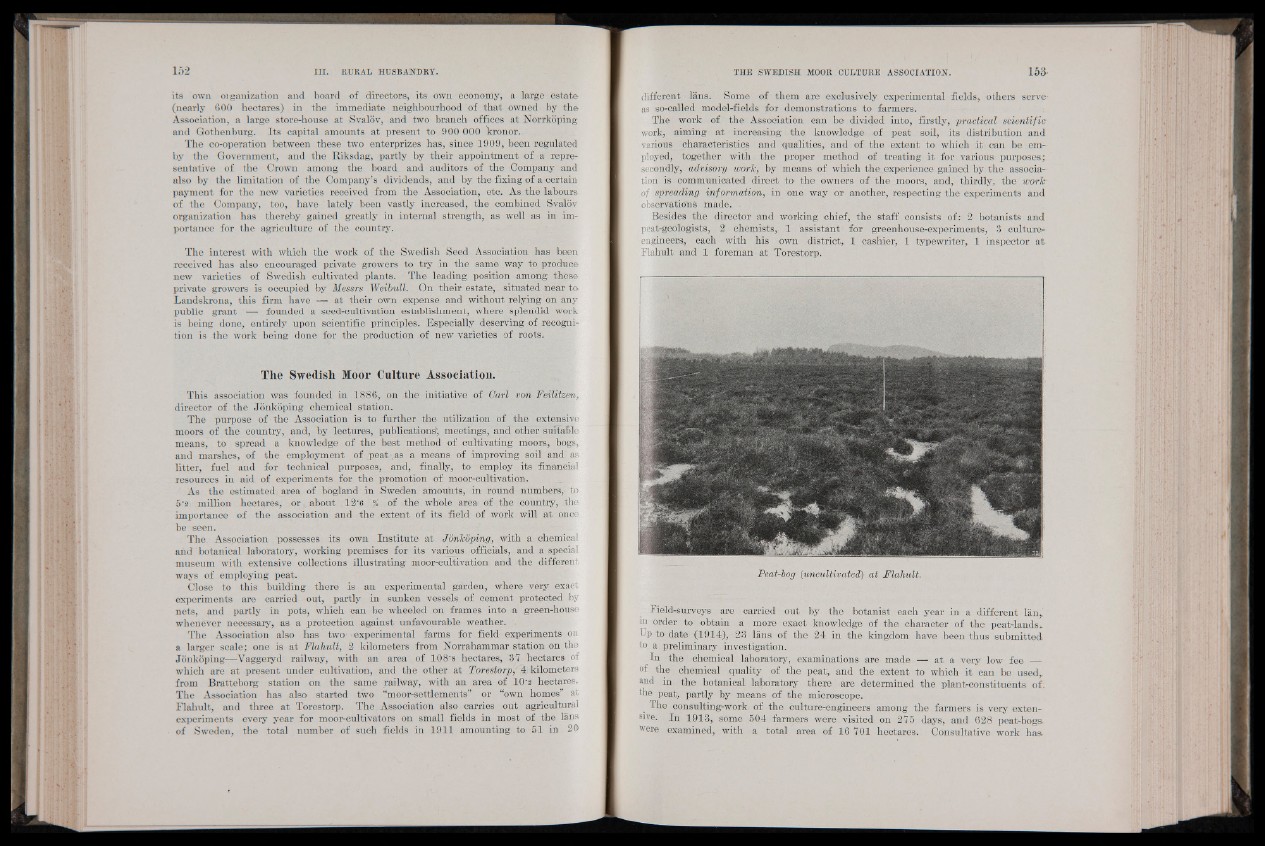
its own o! ganization and board of directors, its own economy, a large estate
(nearly 600 hectares) in the immediate neighbourhood of that owned by the
Association, a large store-house at Svalôv, and two branch offices at Norrkôping
and Gothenburg. Its capital amounts at present to 900 000 kionoi -
The co-operation between these two enterprizes has, since 1909, been regulated
by the Government, and the Riksdag, partly by their appointment o f a representative
of the Crown among the board and auditors of the Company and
also by the limitation of the Company’s dividends, and by the fixing of a certain
payment for the new varieties received from the Association, etc. As the labours
of the Company, too, have lately been vastly increased, the combined Svalov
organization has thereby gained greatly in internal strength, as well as in importance
for the agriculture of the country.
The interest with which the work of the Swedish Seed Association has been
received has also encouraged private growers to try in the same way to produce
new varieties of Swedish cultivated plants. The leading position among thèse
private growers is occupied by Messrs Weibull. On their estate, situated near to
Landskrona, this firm have —- at their own expense and without relying on any
public grant — founded a seed-cultivation establishment, where splendid work
is being done, entirely upon scientific principles. Especially deserving of recognition
is the work being done for the production of new varieties of roots.
The Swedish Moor Culture Association.
This association was founded in 1886, on the initiative of Carl von Feilitzen,
director of the Jonkoping chemical station.
The purpose of the Association is to further the utilization of the extensive
moors of the country, and, by lectures, publications', meetings, and other suitable
means, to spread a knowledge of the best method of cultivating moors, bogs,
and marshes, of the employment of peat , as a means of improving soil and as
litter, fuel and for technical purposes, and, finally, to employ its financial
resources in aid of experiments for the promotion of mooKultivation.
As the estimated', area of bogland in Sweden amounts) in round numbers, to
5-a million hectares, or , about . 1 2 ‘6 % of the whole area of the country, .the
importance of the association and the extent of its field of work will at once
be seen.
The Association possesses its own Institute at Jonkoping, with a chemical
and botanical laboratory, working premises for its various officials, and a special
museum with extensive collections illustrating moor-cultivation and the different
ways of employing peat.
Close to this building there is an experimental garden, where very exact
experiments are carried out, partly in sunken vessels of cement protected by
nets, and partly in pots, which can be wheeled on frames into a green-house
whenever necessary, as a protection against unfavourable weather. .
The Association also has two .experimental farms for field experiments on
a larger scale; one is at Flahult, 2 kilometers from Norrahammar station on the
Jonkoping—Vaggeryd railway, with an area of 1 0 . 8 ' S hectares, 37 hectares of
which are at present under cultivation, and the other at Torestorp,' % kilometers
from Bratteborg station on the same railway, with an area of 10'2 hectares.
The Association has also started two “moor-settlements” or “own homes” at
Flahult, and three at Torestorp. The Association also carries out agricultural
experiments every year for moor-cultivators on small fields in most of the Ians
of Sweden, the total number of such fields in 1911 amounting to 51 in 20
different Ians. Some of them are exclusively experimental fields, others serve-
as so-called model-fields for demonstrations to farmers.
The work of the Association can be divided into, firstly, practical scientific
work, aiming at increasing the knowledge—o f peat soil, its distribution and
various characteristics and qualities, and of the extent to which it can be employed,
together with the proper method of treating it for various purposes;
secondly, advisory work, by means of which the experience gained by the association,
is communicated direct to the owners of the moors, and, thirdly, the work
of spreading information, in one way o;r another, respecting the experiments and
observations made.
Besides the director and working chief, the staff consists of: 2 botanists and
peat-geologists, 2 chemists,.- 1 assistant for greenhouse-experiments, 3 culture-
engineers, each with his own district, 1 .cashier, 1 typewriter, 1 inspector at
Flahult and 1 foreman at Torestorp.
Peat-bog (uncultivated) at Flahult.
Field-surveys are carried out by the botanist each year in a different lan,
m order to obtain a more exact knowledge of the character of the peat-lands..
Bp to date (1914), 23 Ians of the 24 in the kingdom have been thus submitted,
to a preliminary investigation.
In the chemical laboratory, examinations are made — at a very low fee —j
of the chemical quality of the peat, and the extent to which it can be used,,
and in the botanical laboratory there are determined the plant-constituents of:
the peat, partly by means of the microscope.
The consulting-work of the culture-engineers among the farmers is very extensive.
In 1913, some 504 farmers were visited on 275 days, and 628 peat-bogs-
HJpj examined, with a total area of 16 701 hectares. Consultative work has.